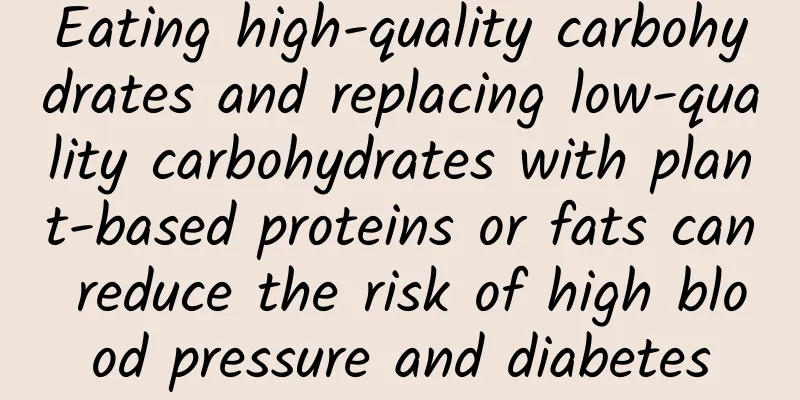Eating high-quality carbohydrates and replacing low-quality carbohydrates with plant-based proteins or fats can reduce the risk of high blood pressure and diabetes

|
Hypertension and diabetes are the main risk factors for cardiovascular disease and premature death. At present, about 250 million adults in China suffer from hypertension and about 120 million adults suffer from diabetes. Therefore, finding more modifiable risk factors for primary prevention of hypertension and diabetes has important clinical and public health significance. The three macronutrients of carbohydrates, proteins and fats are basic substances for human energy supply and life-sustaining activities. However, the prospective relationship between carbohydrate intake and type and new-onset hypertension and new-onset diabetes remains uncertain. The picture comes from the Internet, the copyright belongs to the original author In response to the above problems, the School of Public Health of Anhui Medical University, Anhui Institute of Biomedical Sciences, and National Clinical Research Center for Kidney Diseases of Nanfang Hospital jointly conducted relevant research and published them in Hypertension (first author: Li Qinqin ) and Metabolism (first author: Zhou Chun ). Studies have shown that in general Chinese adults, there is an appropriate range of total carbohydrate intake. Too high or too low intake will increase the risk of new hypertension and new diabetes. At the same time, consuming high-quality carbohydrates and replacing low-quality carbohydrates with plant-based protein or fat can reduce the risk of hypertension and diabetes in the Chinese population. This series of studies included more than 10,000 adult participants from the China Health and Nutrition Survey. The intake of various foods was assessed using a 3-day 24-hour dietary recall and household food inventory weighing method. New-onset diabetes was defined as self-reported physician-diagnosed diabetes or fasting blood glucose ≥7.0mmol/L or glycated hemoglobin ≥6.5%; new-onset hypertension was defined as systolic blood pressure ≥140mmHg or diastolic blood pressure ≥90mmHg or physician-diagnosed hypertension or taking antihypertensive drugs. The study found that there was a U-shaped relationship between total carbohydrate intake and new-onset hypertension and new-onset diabetes. When the energy proportion of carbohydrate intake was 50% to 55%, the risk of new-onset hypertension and new-onset diabetes was the lowest. Further research found that high-quality carbohydrate intake was L-shapedly correlated with the risk of new-onset hypertension and new-onset diabetes, and low-quality carbohydrate intake was J-shapedly correlated with the risk of new-onset hypertension and new-onset diabetes (Figure 1); indicating that the increased risk of new-onset hypertension and diabetes may be mainly due to the low proportion of high-quality carbohydrate intake in energy, while the high proportion of low-quality carbohydrate intake in energy. Figure 1. Relationship between total carbohydrate intake (A), high-quality carbohydrate intake (B), and low-quality carbohydrate intake (C) and new-onset hypertension and new-onset diabetes The researchers further defined the low-carbohydrate diet (LCD) score for low-quality carbohydrates. The LCD score for low-quality carbohydrates is to divide the intake of fat, protein, and carbohydrates into 11 levels. Participants in the highest stratum of protein and fat intake received 10 points, while those in the lowest stratum received 0 points; participants in the highest stratum of low-quality carbohydrate intake received 0 points, while those in the lowest stratum received 10 points; the total score ranged from 0 to 30 points. Studies have shown that the total LCD and animal LCD of low-quality carbohydrates are both U-shapedly associated with new-onset hypertension, while plant LCD is L-shapedly associated with new-onset hypertension. The LCD score of low-quality carbohydrates and the risk of new-onset diabetes also show a similar correlation (Figure 2); indicating that replacing low-quality carbohydrates with plant protein or fat can be more conducive to reducing the risk of hypertension and diabetes in the Chinese population. Figure 2. Relationship between total LCD score (A), animal-based low LCD score (B), and plant-based LCD score (C) in a low-carbohydrate diet and new-onset hypertension and new-onset diabetes The above series of studies show that there is an appropriate range of carbohydrate intake in the general adult population in China. Too high or too low intake will increase the risk of new hypertension and new diabetes. At the same time, the intake of high-quality carbohydrates and the replacement of low-quality carbohydrates with plant protein or fat are associated with a lower risk of hypertension and diabetes. This study supports the Chinese population to consume high-quality carbohydrates and replace low-quality carbohydrates with plant products to strengthen the primary prevention of hypertension and diabetes and promote group health. Information Points 1. Classification of high-quality carbohydrate sources: ① Whole grains: wheat, barley, millet, millet flour, sorghum rice, corn, corn flour, black rice, etc. ② Fruits: Any fresh, canned, frozen or dried fruit, including whole, cut or juiced types. ③ Beans: tofu or other soy products. ④ Non-starchy vegetables: soybeans, peas, kale, spinach, cauliflower, cucumbers, peppers, onions, tomatoes, asparagus, carrots, sweet potatoes, pumpkins, winter melons, bamboo shoots, etc. 2. Classification of low-quality carbohydrate sources: ① Fine grains: refined white flour, refined rice, white steamed buns, white bread, white noodles, etc. ② Starchy vegetables: potatoes, cassava, raw corn, taro, yam, lotus root, water chestnuts, immature green beans, etc. ③ Added sugar: sugar, candy, sugary drinks, candied fruits, desserts, cakes, etc. ④ 100% juice: 100% orange juice, apple juice, mixed juice, or 100% other juice, etc. References: [1] Li Q, Liu C, Zhang S, Li R, Zhang Y, He P, Zhang Z, Liu M, Zhou C, Ye Z, Wu Q, Li H, Qin X. Dietary Carbohydrate Intake and New-Onset Hypertension: A Nationwide Cohort Study in China. Hypertension. 2021 Aug;78(2):422-430. [2] Zhou C, Zhang Z, Liu M, Zhang Y, Li H, He P, Li Q, Liu C, Qin X. Dietary carbohydrate intake and new-onset diabetes: A nationwide cohort study in China. Metabolism. 2021 Oct; 123:154865. Editor | Zhou Chun, Li Qinqin, Wu Yiting Audit | Qin Xianhui Reprint: Please contact us and indicate the source |
>>: If the cough is severe and lasts for a long time, you must be careful about this disease
Recommend
Is it okay for women to get sterilized?
Sterilization is a relatively common method of co...
Is third degree cervical erosion serious?
Gynecologists often say "nine out of ten wom...
Symptoms of early pregnancy fetal arrest
The pregnancy process is a long and arduous one, ...
Who is suitable to drink corn silk boiled water (it can fight free radicals and lower blood sugar)
...
What are the pathological classifications of uterine fibroids?
A woman's uterus is the organ that bears chil...
What are the sea activities in Sanya? What is the big pineapple in Dadonghai, Sanya called?
When traveling to Sanya, you need to prepare suns...
What are the pathological classifications of endometrial hyperplasia?
The endometrium is an important component of the ...
Do you need to blanch beans for steamed buns stuffed with beans? How can you make the beef filling for steamed buns tender and juicy?
Steamed buns are a traditional Chinese food. Thei...
It is easy to accumulate but difficult to reduce. How can you quickly reduce the fat on your waist and abdomen?
Summer is coming, and many people are beginning t...
Does cervical retention cyst need treatment?
Cervical retention cyst is mainly a manifestation...
Causes of breast pain during menopause
After women enter middle age, they will enter men...
App Annie: Global App Market Report for the Second Quarter of 2018
In the second quarter of 2018, global app downloa...
What is the cause of blood deficiency and scanty menstruation?
In traditional Chinese health care, we often see ...
What are the effects of getting angry during confinement?
Confinement is a very special period for women. I...
If your vulva is itchy and has an odor, don’t use medication blindly!
When summer comes, it is a very happy time for wo...









